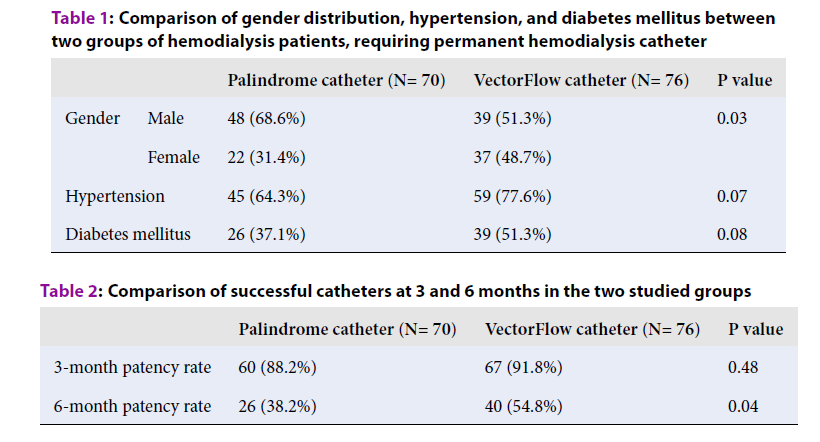Comparison of the efficacy of two types of hemodialysis catheters: the VectorFlow vs. Palindrome catheters
DOI:
https://doi.org/10.15419/bmrat.v6i6.551Keywords:
End stage renal disease, hemodialysis, permanent catheter, hemodialysis catheter, VectorFlow, PalindromeAbstract
Introduction: Permanent vascular access via catheters is a critical factor for patients who need long-term hemodialysis. Differences in the design and mechanical factors can affect efficacy and survival of the permanent catheters. Modifications in the designs of the catheters can decrease the likelihood of damaging blood vessels as well as thrombosis formation and malfunction of the catheters.
Objective: To compare survival of VectorFlow, complete symmetry of distal tip and offsetting of its side holes, with those of Palindrome, a complete symmetrical catheter.
Methods: In this study, 146 CKD (chronic kidney disease) patients who required chronic hemodialysis were divided into VectrFlow (76 subjects) and Palindrome (70 subjects) catheter groups. The patients were followed for six months and the survival rate in each group was determined.
Results: Mean (+/-SD) survival time in the VectorFlow catheter group (6.55+/-3.88 months, 2 to 24 months) was longer than in the Palindrome catheter group (5.22+/-2.88 months, one to 13 months). After six months, the VectorFlow catheter group (40 cases, 54.8%) had a higher number of patients, having a functioning catheter in place than the Palindrome group (26 cases, 382%); P= 0.04.
Conclusion: The VectorFlow hemodialysis catheter had a better survival rate after 6 months when compared to the Palindrome catheter. We recommend using this catheter in CKD patients, who require a long-term permanent catheter.

Downloads
Published
Issue
Section
License
Copyright The Author(s) 2017. This article is published with open access by BioMedPress. This article is distributed under the terms of the Creative Commons Attribution License (CC-BY 4.0) which permits any use, distribution, and reproduction in any medium, provided the original author(s) and the source are credited.
